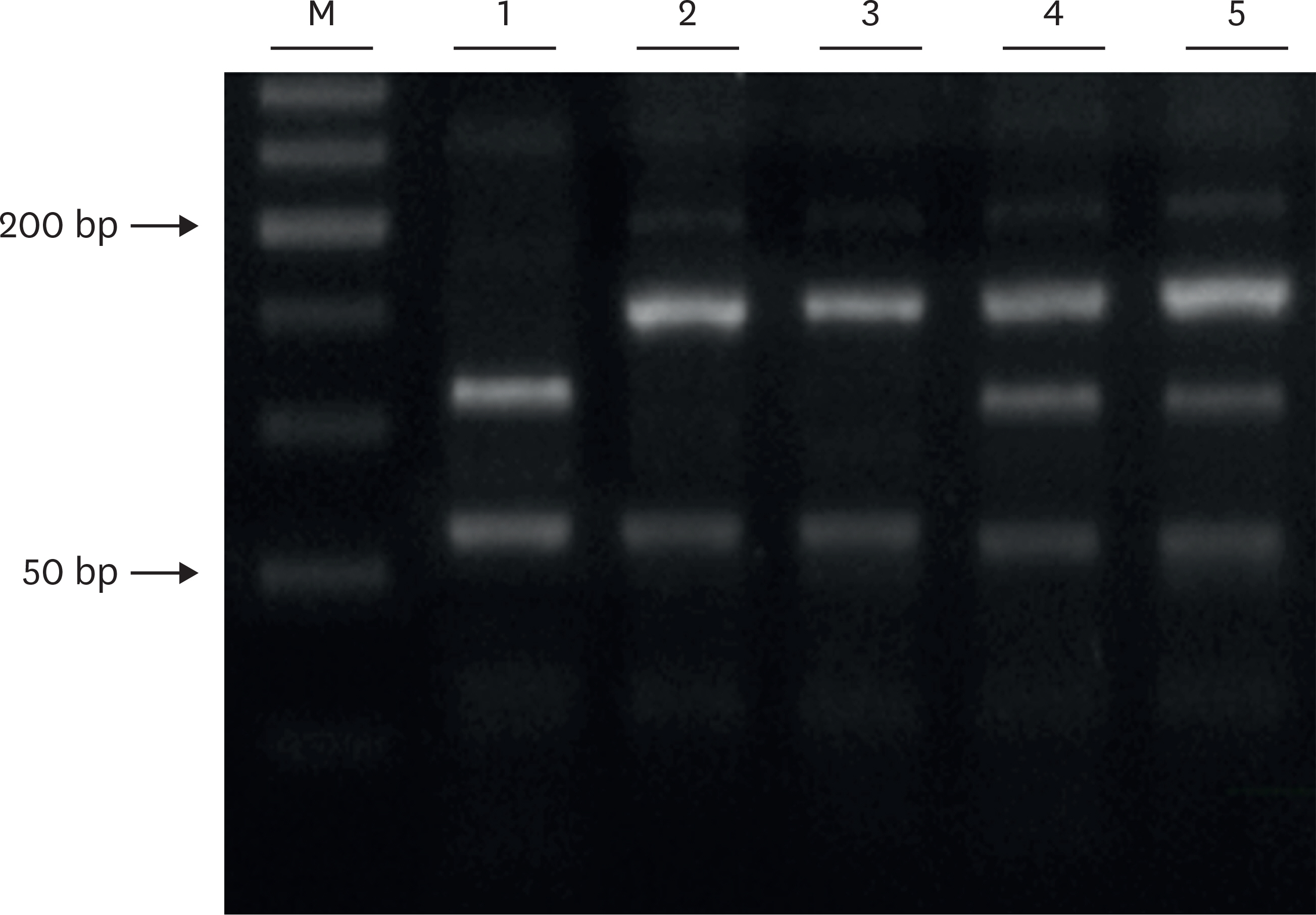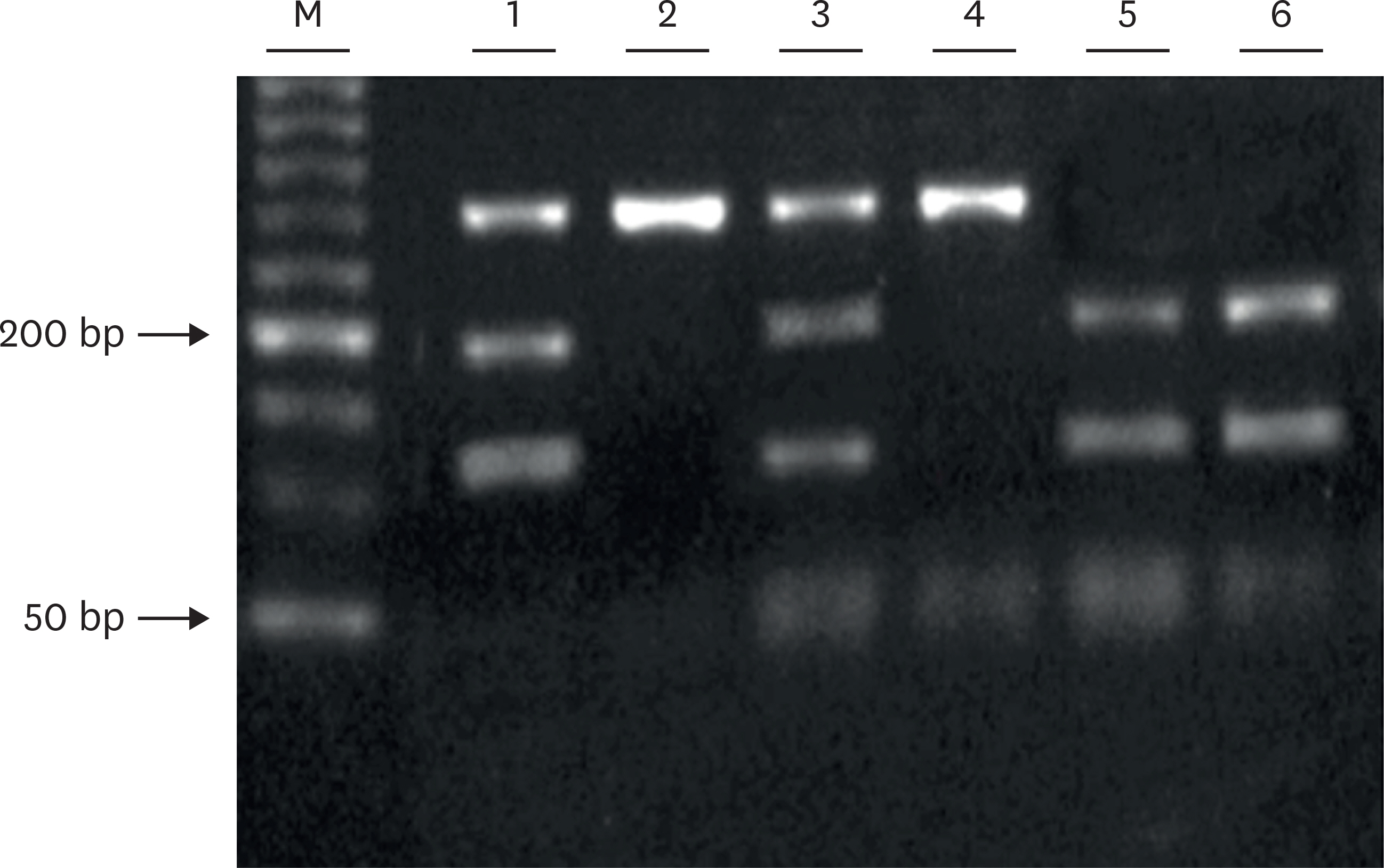Asia Pac Allergy.
2019 Jul;9(3):e22. 10.5415/apallergy.2019.9.e22.
Association of IL-1 gene polymorphisms with chronic rhinosinusitis with and without nasal polyp
- Affiliations
-
- 1Department of Otorhinolaryngology-Head & Neck Surgery, School of Medical Sciences, Health Campus, Universiti Sains Malaysia, Kubang Kerian, Kelantan, Malaysia. tr_kmkstuds03@yahoo.com
- 2Basic Science and Oral Biology Unit, School of Dental Sciences, Health Campus, Universiti Sains Malaysia, Kubang Kerian, Kelantan, Malaysia.
- KMID: 2454156
- DOI: http://doi.org/10.5415/apallergy.2019.9.e22
Abstract
- BACKGROUND
Chronic rhinosinusitis (CRS) is one of the most common and complex chronic inflammatory disease of sinonasal mucosa. Even though the pathogenesis of CRS is multifactorial and still unclear, the role of cytokines especially interleukin-1 (IL-1) is being investigated worldwide in different population because of varying results obtained.
OBJECTIVE
To study the association of IL-1 (A and B) gene polymorphisms with chronic rhinosinusitis with nasal polyp (CRSwNP) and without nasal polyp (CRSsNP), and other factors related.
METHODS
This is a case-controlled study which include a total of 138 subjects recruited from Otorhinolaryngology-Head and Neck Surgery clinic in Hospital Universiti Sains Malaysia. Genotyping of the IL-1A (+4845G, +4845T) and IL-1B (−511C, −511T) were performed with restriction fragment length polymorphism analysis.
RESULTS
There was a statistical significant association between IL-1B (−511C, −511T) polymorphism with CRSwNP and CRSsNP (p < 0.001). The CT genotype of IL-1B was markedly increased in CRSwNP subjects (52.2%). However, there was no significant association found between IL-1A (+4845G, +4845T) with CRSwNP and CRSsNP (p = 0.093). No association was found in factors related to CRS, which included asthma, atopy, allergy, aspirin sensitivity, and family history of nasal polyp (p value of 0.382, 0.382, 0.144, >0.95, and 0.254, respectively).
CONCLUSION
This study indicates an association of IL-1B (−511C, −511T) polymorphism with CRSwNP and CRSsNP in our population, hence there is a possibility of IL-1B involvement in modulating pathogenesis of CRS. There was no significant association of IL-1A (+4845G, +4845T) polymorphism with CRSwNP and CRSsNP, and other factors related.
MeSH Terms
Figure
Cited by 1 articles
-
Actions needed for “Allergy in Asia-Pacific”
Jiu-Yao Wang
Asia Pac Allergy. 2019;9(3):. doi: 10.5415/apallergy.2019.9.e27.
Reference
-
References
1. Fokkens WJ, Lund VJ, Mullol J, Bachert C, Alobid I, Baroody F, Cohen N, Cervin A, Douglas R, Gevaert P, Georgalas C, Goossens H, Harvey R, Hellings P, Hopkins C, Jones N, Joos G, Kalogjera L, Kern B, Kowalski M, Price D, Riechelmann H, Schlosser R, Senior B, Thomas M, Toskala E, Voegels R, Wang de Y, Wormald PJ. EPOS 2012: European position paper on rhinosinusitis and nasal polyps 2012. A summary for otorhinolaryngologists. Rhinology. 2012; 50:1–12.
Article2. Hastan D, Fokkens WJ, Bachert C, Newson RB, Bislimovska J, Bockelbrink A, Bousquet PJ, Brozek G, Bruno A, Dahlén SE, Forsberg B, Gunnbjörnsdóttir M, Kasper L, Krämer U, Kowalski ML, Lange B, Lundbäck B, Salagean E, Todo-Bom A, Tomassen P, Toskala E, van Drunen CM, Bousquet J, Zuberbier T, Jarvis D, Burney P. Chronic rhinosinusitis in European underestimated disease. A GA²LEN study. Allergy. 2011; 66:1216–23.3. Shi JB, Fu QL, Zhang H, Cheng L, Wang YJ, Zhu DD, Lv W, Liu SX, Li PZ, Ou CQ, Xu G. Epidemiology of chronic rhinosinusitis: results from a cross-sectional survey in seven Chinese cities. Allergy. 2015; 70:533–9.4. Lam M, Hull L, Imrie A, Snidvongs K, Chin D, Pratt E, Kalish L, Sacks R, Earls P, Sewell W, Harvey RJ. Interleukin-25 and interleukin-33 as mediators of eosinophilic inflammation in chronic rhinosinusitis. Am J Rhinol Allergy. 2015; 29:175–81.
Article5. Erbek SS, Yurtcu E, Erbek S, Atac FB, Sahin FI, Cakmak O. Proinflammatory cytokine single nucleotide polymorphisms in nasal polyposis. Arch Otolaryngol Head Neck Surg. 2007; 133:705–9.
Article6. Mfuna Endam L, Cormier C, Bossé Y, Filali-Mouhim A, Desrosiers M. Association of IL1A, IL1B, and TNF gene polymorphisms with chronic rhinosinusitis with and without nasal polyposis: a replication study. Arch Otolaryngol Head Neck Surg. 2010; 136:187–92.7. Bachert C, Zhang N, van Zele T, Gevaert P. Chronic rhinosinusitis: from one disease to different phenotypes. Pediatr Allergy Immunol. 2012; 23(Suppl 22):2–4.
Article8. Kramer MF, Rasp G. Nasal polyposis: eosinophils and interleukin-5. Allergy. 1999; 54:669–80.
Article9. Banerji A, Piccirillo JF, Thawley SE, Levitt RG, Schechtman KB, Kramper MA, Hamilos DL. Chronic rhinosinusitis patients with polyps or polypoid mucosa have a greater burden of illness. Am J Rhinol. 2007; 21:19–26.
Article10. Misron K, Hamid SSA, Ahmad A, Ramli RR. A study of single nucleotide polymorphisms of tumour necrosis factor α-1031 and tumour necrosis factor β+ 252 in chronic rhinosinusitis. Clin Exp Otorhinolaryngol. 2017; 10:241–7.
Article11. Kato A. Immunopathology of chronic rhinosinusitis. Allergol Int. 2015; 64:121–30.
Article12. Cheng YK, Lin CD, Chang WC, Hwang GY, Tsai SW, Wan L, Tsai MH, Tsai JJ, Tsai FJ. Increased prevalence of interleukin-1 receptor antagonist gene polymorphism in patients with chronic rhinosinusitis. Arch Otolaryngol Head Neck Surg. 2006; 132:285–90.
Article13. Forrester JV, Dick AD, McMenamin PG, Roberts F, Pearlman E. The eye e-book: basic sciences in practice. 4th ed.London: Elsevier Health Sciences;2015. Genetics; p.p. 130–56.14. Karjalainen J, Joki-Erkkilä VP, Hulkkonen J, Pessi T, Nieminen MM, Aromaa A, Klaukka T, Hurme M. The IL1A genotype is associated with nasal polyposis in asthmatic adults. Allergy. 2003; 58:393–6.
Article15. Bernstein JM, Anon JB, Rontal M, Conroy J, Wang C, Sucheston L. Genetic polymorphisms in chronic hyperplastic sinusitis with nasal polyposis. Laryngoscope. 2009; 119:1258–64.
Article16. Prakash PS, Victor DJ. Interleukin-1b gene polymorphism and its association with chronic periodontitis in South Indian population. Int J Genet Mol Biol. 2010; 2:179–83.17. Ligumsky M, Simon PL, Karmeli F, Rachmilewitz D. Role of interleukin 1 in inflammatory bowel disease–enhanced production during active disease. Gut. 1990; 31:686–9.
Article18. Bresnihan B, Alvaro-Gracia JM, Cobby M, Doherty M, Domljan Z, Emery P, Nuki G, Pavelka K, Rau R, Rozman B, Watt I, Williams B, Aitchison R, McCabe D, Musikic P. Treatment of rheumatoid arthritis with recombinant human interleukin-1 receptor antagonist. Arthritis Rheum. 1998; 41:2196–204.
Article19. Dumusc A, So A. Interleukin-1 as a therapeutic target in gout. Curr Opin Rheumatol. 2015; 27:156–63.
Article20. Lund VJ. Diagnosis and treatment of nasal polyps. BMJ. 1995; 311:1411–4.21. Dinarte VRP, Santos ARDD, Araújo LF, Reis MGAD, Tamashiro E, Valera FCP, Silva Júnior WAD, Anselmo-Lima WT. Polymorphisms in chronic rhinosinusitis with nasal polyps – a systematic review. Braz J Otorhinolaryngol. 2017; 83:705–11.
Article22. Zimmermann P, Ziesenitz VC, Curtis N, Ritz N. The immunomodulatory effects of macrolides-a systematic review of the underlying mechanisms. Front Immunol. 2018; 9:302.
Article23. Hur K, Liang J, Lin SY. The role of secondhand smoke in sinusitis: a systematic review. Int Forum Allergy Rhinol. 2014; 4:22–8.
Article24. Lam K, Hirsch AG, Tan BK. The association of premorbid diseases with chronic rhinosinusitis with and without polyps. Curr Opin Otolaryngol Head Neck Surg. 2014; 22:231–41.
Article25. Tint D, Kubala S, Toskala E. Risk factors and comorbidities in chronic rhinosinusitis. Curr Allergy Asthma Rep. 2016; 16:16.
Article26. Gao R, Li X. Risk assessment and aspirin use in Asian and Western populations. Vasc Health Risk Manag. 2010; 6:943–56.27. Rugina M, Serrano E, Klossek JM, Crampette L, Stoll D, Bebear JP, Perrahia M, Rouvier P, Peynegre R. Epidemiological and clinical aspects of nasal polyposis in France; the ORLI group experience. Rhinology. 2002; 40:75–9.28. Alexiou A, Sourtzi P, Dimakopoulou K, Manolis E, Velonakis E. Nasal polyps: heredity, allergies, and environmental and occupational exposure. J Otolaryngol Head Neck Surg. 2011; 40:58–63.29. Lockey RF, Rucknagel DL, Vanselow NA. Familial occurrence of asthma, nasal polyps and aspirin intolerance. Ann Intern Med. 1973; 78:57–63.
Article
- Full Text Links
- Actions
-
Cited
- CITED
-
- Close
- Share
- Similar articles
-
- Update on Biologics in Treatment of Chronic Rhinosinusitis With Nasal Polyposis
- The Role of Allergy in the Severity of Chronic Rhinosinusitis
- Effect of Macrolide on the MUC4 Gene Expression in Human Airway Epithelial Cells
- Clinical Characteristics and Expression Pattern of IL-33 and IL-25 According to Histologic Classification in Chronic Rhinosinusitis with Nasal Polyposis
- Biomarkers in Chronic Rhinosinusitis with Nasal Polyp: Personalized Medicine Based on Endotype



